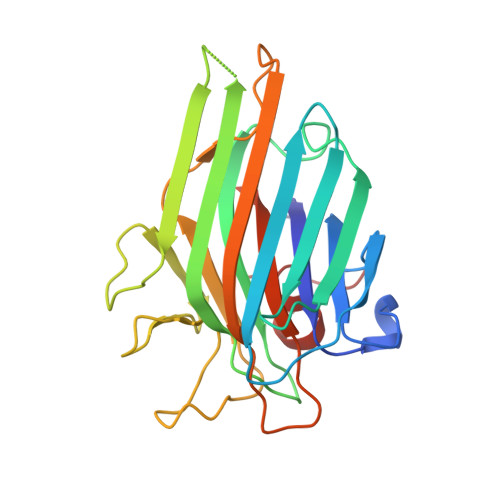Vasorelaxant activity of Canavalia grandiflora seed lectin: A structural analysis.
Barroso-Neto, I.L., Simoes, R.C., Rocha, B.A., Bezerra, M.J., Pereira-Junior, F.N., Silva Osterne, V.J., Nascimento, K.S., Nagano, C.S., Delatorre, P., Pereira, M.G., Freitas Pires, A., Sampaio, A.H., Assreuy, A.M., Cavada, B.S.(2014) Arch Biochem Biophys 543: 31-39
- PubMed: 24361256
- DOI: https://doi.org/10.1016/j.abb.2013.12.006
- Primary Citation of Related Structures:
4L8Q - PubMed Abstract:
Lectins are comprised of a large family of proteins capable of the specific and reversible recognition of carbohydrates. Legume lectins, the most studied plant lectins, show high structural similarity, but with modifications that imply a variation in the intensity of some biological activities. In this work, the primary and tertiary structures of Canavalia grandiflora (ConGF) were determined. ConGF, a lectin isolated from C. grandiflora seeds, is able to induce relaxant activity in rat aortic rings. The complete sequence of ConGF comprises 237 amino acids. This particular protein has primary sequence variations commonly found in lectins from Dioclea and Canavalia genera. The protein structure was solved at 2.3 Å resolution by X-ray crystallography. An X-Man molecule was modeled into the carbohydrate recognition domain. Still, ConGF (30 and 100 μg mL(-1)) elicited 25% of vasorelaxation (IC50=34.48 ± 5.07 μg mL(-1)) in endothelialized aortic rings. A nonselective inhibitor of nitric oxide blocked ConGF relaxant effect, showing mediation by nitric oxide. Key distances between ConGF carbohydrate recognition domain residues were determined in order to explain this effect, in turn revealing some structural aspects that could differentiate lectins from the Canavalia genera with respect to different efficacy in vasorelaxant effect.
- Laboratório de Moléculas Biologicamente Ativas, Universidade Federal do Ceará, Fortaleza, Brazil.
Organizational Affiliation:






















